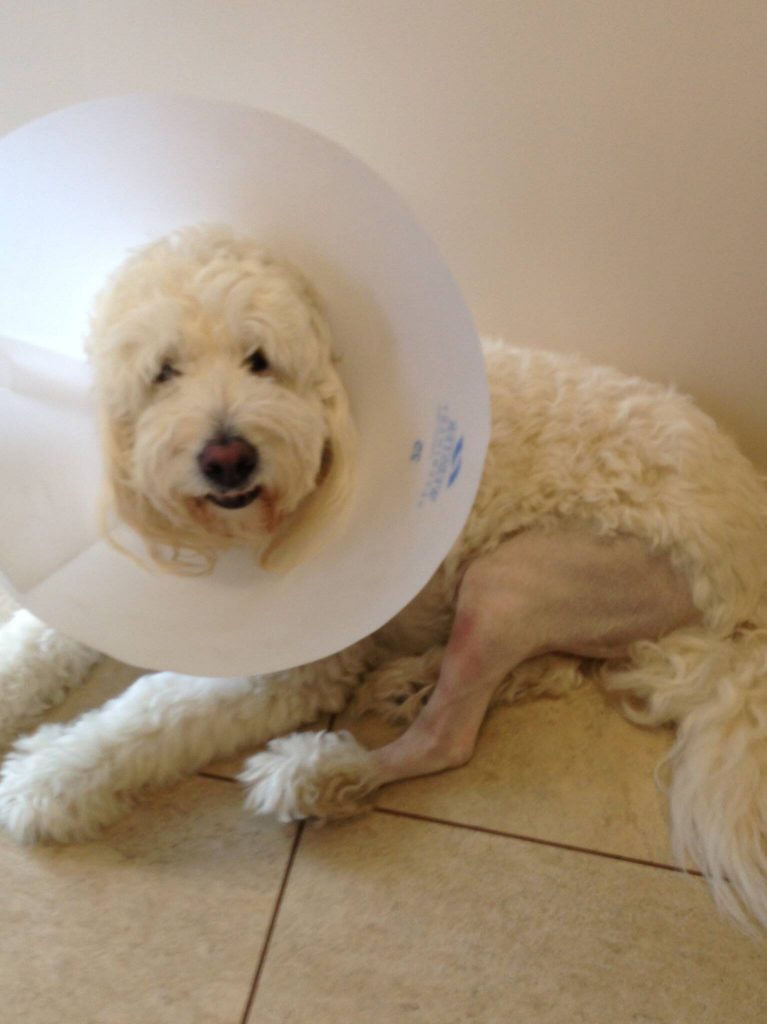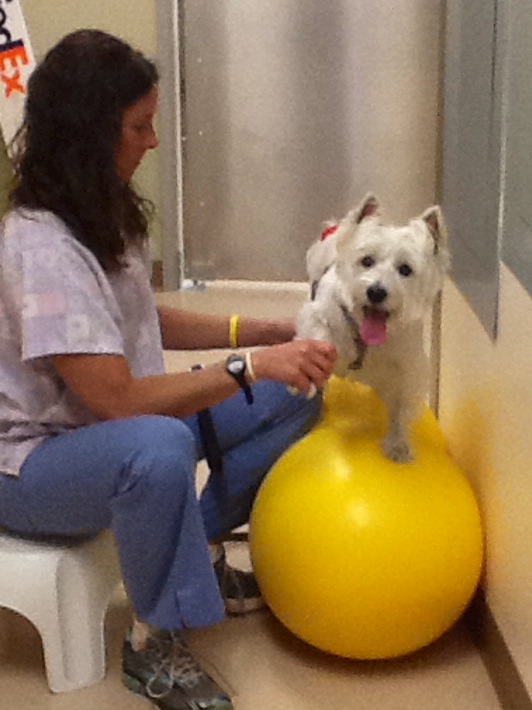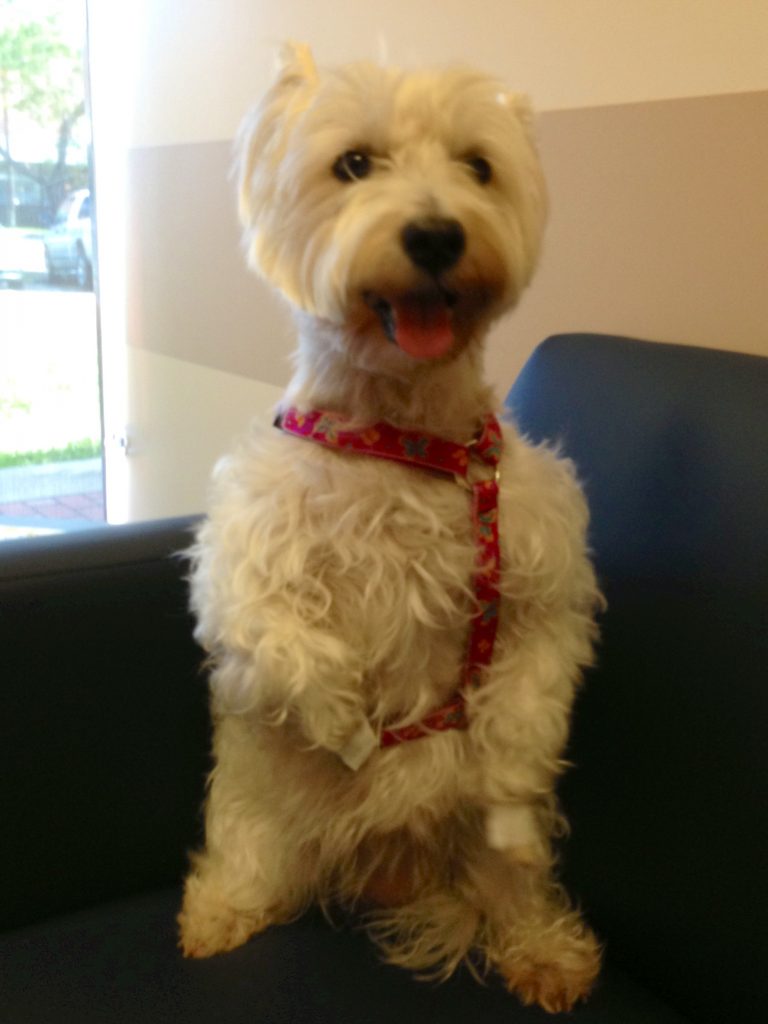
The most common problems I treat in my canine rehabilitation business are anterior cruciate ligament tears. I work with dogs for post-surgical rehabilitation as well as with dogs trying to avoid surgery. Which leads me to the question of dismay I get from Veterinarians and clients alike; A dog with a complete or partial cruciate tear can be effectively rehabilitated without surgery? The answer is…absolutely, as long as the meniscus is not involved.
How do you know if the meniscus is involved? Sometimes owners may hear an audible click when their dog is walking or when bending the stifle (knee joint). Physical therapists are trained in special tests of the musculoskeletal system. These are clinical examination procedures that we use to diagnose injury. Just like in human medicine, these test can be applied to canines to assist in diagnosing injury. The special test used to detect meniscal involvement in canines is the McMurray test, which is the same test used on people. Special tests themselves are not 100% specific, however they do provide clinicians with information that is used to help guide their clinical reasoning. If there is doubt, a minimally invasive arthroscopy can be done to more precisely determine if there is a meniscal tear.
I, along with some very dedicated and diligent owners, have successfully treated numerous dogs without surgery who were diagnosed with complete or partial cruciate tears.. In fact, in humans with ACL (same as the cranial cruciate ligament in canines) tears it has been found that there is no difference in activity level, function, or the presence of osteoarthritis between those who had surgery and rehab, those who had delayed surgery following a course of rehab, and those who had only rehab with no surgery. This comes from a study that found these results at three years post-injury and five years post-injury.
The recommendations from this information are that young athletes and clinicians should consider rehab as the primary treatment option post ACL injury. Therefore, based on this study, as well as results with my own patients, I feel, unless the meniscus is involved and/or the joint is completely unstable, early rehab is indicated and surgery may not be necessary.

Generally, ruptured cruciates occur when normal forces are exerted on an abnormal or degenerative joint. There are biological and biomechanical factors that can contribute to cruciate tears. Some biological influences include development, genetics, hormonal influences, and metabolic function. Biomechanical influences may include movement, muscular function, and conformation. Dogs built with straighter stifles (knees) are more prone to cruciate problems, as well as dogs spayed or neutered prior to the growth plates closing, which is usually around one year of age. Since cranial cruciate disease is typically degenerative, a patient with a ruptured CCL has a 50-60% chance of rupturing the opposite CCL within 6-12 months. CCL problems can occur in any breed, sex, or age although there is a higher incidence for large breed and overweight dogs, as well as certain breeds such as the Labrador, Newfoundland, Rottweiler, Mastiff, Akita, Boxer, Bulldog, and American Staffordshire Terrier supporting the likelihood of a genetic component.

Typical signs of CCL problems may be limping or holding the leg up completely, warmth at the stifle, and swelling at the stifle. A tell tale sign is that the dog all of a sudden does not want to sit with the leg tucked squarely under the body. Instead, the dog will tend to place the leg out to the side and/or slightly forward when sitting. Sometimes there are reports of intermittent lameness over a period of several weeks to months, which tends to worsen after heavy activity or exercise. He or she may also appear stiff upon rising, especially after prolonged periods of rest. The dog tends to shift weight off of the affected limb when standing.
Typical signs of CCL problems may be limping or holding the leg up completely, warmth at the stifle, and swelling at the stifle. A tell tale sign is that the dog all of a sudden does not want to sit with the leg tucked squarely under the body. Instead, the dog will tend to place the leg out to the side and/or slightly forward when sitting. Sometimes there are reports of intermittent lameness over a period of several weeks to months, which tends to worsen after heavy activity or exercise. He or she may also appear stiff upon rising, especially after prolonged periods of rest. The dog tends to shift weight off of the affected limb when standing.
Early diagnosis and rehabilitation treatments are crucial for these dogs. Crate rest is an older school of thought and can actually be detrimental to the dog’s return to full function. A study in 2006 showed a much quicker recovery with a formal rehabilitation program versus the “do it at home yourself” method.
Rehab will expedite return to activity, decrease risk for other injuries, and maximize function. To accomplish this, it is vital to get a specifically designed rehabilitation program created for each individual dog’s needs, so as to address the precise problems. Injury and pain affect muscle activity and movement in ways that are not always predictable. These changes in movement and muscle functioning are initially protective. However, these compensations remain in place even after tissue healing has occurred and pain has resolved, which may contribute to future injury or re-injury. Since each dog presents differently, every patient needs his or her own exercise regimen. It is important to address movement dysfunctions so as not to perpetuate compensated movement patterns, as well as any discomfort being experienced, which may be contributing to those compensatory patterns. Different rehabilitation treatment options such as laser therapy, manual therapy involving joint mobilizations, massage, stretching, and range of motion, combined with a neuromuscular re-education and strengthening program is extremely helpful to address the deficits associated with CCL tears. In addition, I help owners address weight concerns and design an appropriate home plan for their dogs. When treating dogs with cruciate tears, I utilize the same treatment approaches that physical therapists use on human patients with ACL tears.
To illustrate all of this, I will give an example of a patient I recently rehabilitated. Courtney Jean is an 8 year old Westie, who had a complete CCL tear without meniscal involvement. Her owner brought her for rehabilitation once a week for six months and was extremely diligent in her home exercise program as well as following the activity restrictions I recommended.
Over the course of the 6 months I treated her with neuromuscular re-education activities to get her muscles firing properly, strengthening and balance work, joint mobilizations, and laser and massage therapy. Some of these activities included exercises such as cavalettis, backwards walking, working on a peanut or bosu, 2 leg standing, crawling, and sitting up into beg position. As she got stronger I gradually increased her activity level and exercise difficulty.
After the 6 month period, not only is Courtney Jean back to running and chasing tennis balls at the dog park for an hour, but her mom and I can not tell which leg she injured a year ago.


However, sometimes surgery is necessary. If a dog does not respond to conservative management or if there is meniscal involvement, surgery should be considered. There are three techniques typically utilized to help stabilize the stifle joint. They are the extracapsular repair, TPLO (Tibial plateau leveling osteotomy), and TTA (tibial tuberosity advancement). They are chosen based on the dog’s size, activity level, age, and concurrent medical conditions. No one technique has proven to be superior to another in terms of complication rates, long-term outcomes, or technical ease.
Regardless of what surgical procedure is performed, a post-operative rehabilitation program is absolutely crucial to expedite healing and return your pet to full function with improved movement techniques. In human medicine it is unheard of for a person to have a cruciate repair and not go for physical therapy immediate following surgery. Just because a dog appears to not have pain and is using the leg does not mean it is fine.
As a matter of fact, it most likely is NOT fine. I had two knee surgeries and know exactly what the pain, rehabilitation, and functional difficulties are like. We go to rehabilitation to help ourselves with these things, so why wouldn’t we offer the same for our best furry friend, companion, and family member who gives us nothing but loyal devotion and love. The option of canine physical rehabilitation is available for this and many other problems. Any rehabilitation is better than no rehabilitation, so find a rehabilitation practitioner for your dog who is certified in canine rehabilitation and let him or her help you get your PUP happier, more comfortable, and functioning at her maximal capacity!

Leave a Reply